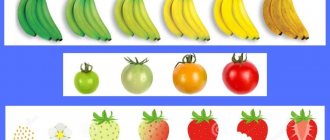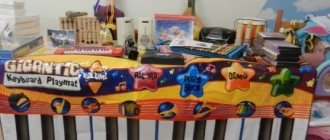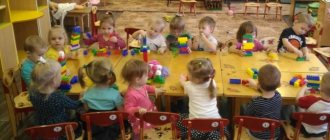Work in a corner of nature
A corner of wildlife in kindergarten is one of the necessary conditions for visually and effectively introducing preschoolers to nature. While caring for the inhabitants of a corner of nature, labor skills and valuable qualities such as hard work, caring for living things, and responsibility for the assigned work are formed.
A child of primary preschool age is taught to carry out simple instructions from adults. Children, with the help of adults, feed fish and rabbits, water houseplants, wipe large leaves, plant bulbs, sow large seeds, water plants in the beds, take part in harvesting from their garden, and feed wintering birds. Work on developing elementary skills in children is organized throughout the year in the form of individual assignments or with subgroups of 2-3 people
The work of young children takes place with the participation of a teacher or under his supervision. The teacher helps the kids if they find it difficult to do something, shows them how to complete the task, and encourages those who have done the assigned work well. When teaching labor skills in nature, children of the younger group are shown each stage of a labor operation, while simultaneously organizing its implementation by all children. The teacher combines demonstration with explanation, and the children perform labor operations step by step. Supervising the work of the children, the teacher names the plants, their parts, and the actions performed in the work; this expands children's vocabulary and activates it. Children look at the plants (“Show where the leaves are small and where they are large”, “Smell the flower”, “Count how many flowers have bloomed”, etc.). The teacher explains the need to care for plants and animals.
In the first junior group, the inhabitants of the corner of nature are looked after by a teacher in the presence of children, who, at his suggestion, bring a watering can, water the plants, feed the fish, etc.
In the second younger group, children themselves, but under the supervision of a teacher, feed the fish and water the plants every day.
When caring for plants, children of the younger group water them with water prepared by an adult (he also determines the dosage), and wipe the large “leathery” leaves of the plants with a damp cloth.
In the corner of nature of the younger groups, plants are placed that have clearly defined main parts (stem, leaves) and bloom beautifully, abundantly and for a long time. It can be ordinary geranium, fuchsia. They also have distinct stems and leaves. Aucuba, camellia, and Chinese rose (small in size) have fairly large and strong leaves on which you can teach children the first simple techniques for keeping plants clean. These same techniques can be taught to children by having young aralia and ficus in the corner.
In the middle group, work becomes more difficult. Preschoolers in the middle group carry out work assignments independently and take care of plants and animals. They water the plants themselves, learn to determine the need for moisture, grow vegetables (sow seeds, water the beds, harvest).
Children learn new techniques for keeping plants clean: using a fine-mesh watering can or spraying plants with small leaves from a spray bottle, wiping jagged leaves with a damp brush or brush, pubescent leaves with a dry brush, etc. At the same time, children are taught to identify dependencies the method of caring for the plant depends on the nature of the leaves: their size, quantity, surface, fragility.
With the help of the teacher, children prepare food for animals (squirrels, hamsters, rabbits, chickens). The teacher explains what food a particular animal needs, what it is called and how to store it. The process of caring for animals is closely connected with observations of them. Children begin to realize the dependence of the growth and development of plants and animal behavior on the quality of care, and their responsibility for them. There is growing concern and attention to the inhabitants of the living corner, who become children's favorites. The skills of children in the middle group are still imperfect, so the teacher needs constant attention to the methods of their work so as not to cause damage to plants and animals. Children in the middle group are more independent at work. When teaching them a new work operation, the teacher shows and explains all the tasks, and then divides it into successive stages (draw a furrow, put seeds, cover with soil, water). Monitoring the implementation of each stage, reminds of the sequence of actions, methods of using equipment, using demonstrations and explanations.
For the older group, plants and animals that require more complex care techniques are placed in a corner of nature; various types of vegetables with different growing seasons are planted in the garden, which makes the work more systematic. The volume of child labor is also increasing. Preschoolers spray plants with a spray bottle, sweep away dust from fuzzy leaves with a brush, and loosen the ground. With the help of the teacher, children feed the plants, recharge the aquarium, dig up the soil in the vegetable garden and flower garden, plant seedlings, and collect seeds of wild plants (to feed wintering birds).
Individual assignments to care for plants and animals become lengthy. The child is tasked with growing a plant as a gift for the kids and mother. 2-3 children are given long-term assignments - to care for a garden bed, a flower bed, etc. In the process of work, the teacher teaches children to observe the growth and development of plants, to note changes that occur, to distinguish plants by their characteristic features, leaves, and seeds. This expands their understanding of the life of plants and animals and arouses keen interest in them.
In the preparatory group , in the process of working in nature, children learn to establish connections between individual phenomena and discover patterns. The beginnings of a materialistic understanding of natural phenomena are being formed. Information about plants and animals and methods of caring for the inhabitants of a living area is expanding. Children’s independence in work matters increases: without being reminded, they determine the need for watering and loosening the soil, replanting plants, sowing seeds in the garden, in the flower garden, and in winter - in a corner of nature where onions and other greens are constantly grown. Children will learn techniques for propagating plants by cuttings, growing seedlings and then replanting them in the ground. Caring for animals in the corner of nature continues (birds, squirrels, rabbits, pigeons, frogs, lizards, etc.).
Children become more responsible for the condition of the living area, vegetable garden and flower garden. Harvesting flowers gives them great joy. They give flowers to parents, treat the kids with grown vegetables, prepare vegetables for vinaigrette (wash them, peel them, take them to the kitchen), and decorate the group room with flowers.
In the senior and preparatory school groups, children are practiced in small groups (2-3 people each).
This is the most common and valuable form of using labor, as it fosters responsibility for the assigned work. All children take turns on duty. With the help of a teacher, they inspect and water the plants in the corner of nature, wipe the leaves, feed the fish and other animals, clean the cages, and sow oats for the birds. When handing over duty, children must tell what they did and what they observed. This teaches them to be more attentive to their responsibilities. From time to time, in a corner of nature, the teacher conducts joint work for the children of the entire group, for example, periodically organizing the washing of indoor plants; In this case, each plant is assigned to two children. The teacher reminds you how to do this. Throughout the year, the teacher makes sure that the children take care of the animals and plants of the corner of nature, work carefully, together, and bring the work they start to the end.
card file "Work in a corner of nature" card file (senior, preparatory group)
Card index: Labor in nature. Senior/preparatory group.
Card No. 1.
Watering indoor plants.
Goal: Teach children to care for indoor plants; water from a watering can
water at room temperature; consolidate children's knowledge about different methods of watering indoor plants. Develop accuracy when working with water and plants, confidence in your actions, work skills. Foster a caring attitude towards the natural environment and a desire to take care of it.
Card No. 2.
Loosening the soil of indoor plants.
Goal: Teach children to care for indoor plants; give children knowledge about why it is necessary to loosen the soil of plants; consolidate loosening techniques and rules for using the necessary items for this. Develop labor skills, accuracy. Foster an ecological culture and respect for the environment.
Card number 3.
Spraying indoor plants.
Goal: To teach children to provide all possible assistance to the teacher in caring for indoor flowers: spray the plants with water at room temperature, use the sprayer correctly. Develop labor skills and habits, accuracy when working with water and plants. Foster an ecological culture, a caring attitude towards the natural environment, and a desire to take care of it.
Card number 4.
Caring for large-leaved plants (wet wiping of leaves).
Goal: To teach children to provide all possible assistance to the teacher in caring for indoor flowers: wipe large leaves of plants with a damp cloth, being careful. Give children the knowledge that this method of care makes it easier for plants to breathe, which determines their growth and development. Develop labor skills and habits, accuracy when working with water and plants. Foster an ecological culture, a caring attitude towards the natural environment, and a desire to take care of it.
Card number 5.
Caring for plant leaves (removing dust with brushes and a dry cloth)
Goal: To teach children to provide all possible assistance to the teacher in caring for indoor flowers: remove dust from plants with brushes or dry cloths, being careful. Give children the knowledge that this method of care makes it easier for plants to breathe, which determines their growth and development, and improves their appearance. Develop labor skills and habits, accuracy when working with water and plants. Foster an ecological culture, a caring attitude towards the natural environment, and a desire to take care of it.
Card number 6.
Plant cuttings.
Goal: To clarify children’s knowledge of what a plant can be grown from.
Teach children how to properly plant a plant cutting, prepare the soil, care for them and the sequence of work: pour sand into the bottom of the pot, then soil, water, wait until the water is absorbed into the sand, make a hole in the middle (center) of the pot with a stick and plant the cutting until the first leaf, press the ground. Water as needed. Develop labor skills and habits, accuracy when working with water and plants. Foster an ecological culture, a caring attitude towards the natural environment, and a desire to take care of it.
Card number 7.
Replanting indoor plants.
Goal: To teach children to provide all possible assistance to the teacher in replanting plants; teach plant transplantation techniques and sequences
work: choose the right size pot, prepare sand and soil, plant. To consolidate children's knowledge about indoor plants and their differences from each other. Develop labor skills and habits, accuracy when working with land, water and plants. Foster an ecological culture, a caring attitude towards the natural environment, and a desire to take care of it.
Card No. 8
Planting onions on the windowsill.
Goal: To teach children to set a goal, prepare a workplace, tools and clean up after themselves. To consolidate children's knowledge about the structure of the onion and the conditions necessary for onion growth. Develop labor skills and habits, accuracy when working with land, water and plants. Foster an environmental culture, a desire to achieve results, and participate in a common cause.
Card number 9.
Sowing flower and vegetable seeds.
Goal: To give children knowledge that every plant has seeds. Learn the sequence of actions required when sowing seeds; make a hole in the soil (for sowing seeds, marking each time with a stick
the distance between them and grooves for small seeds; teach to observe cultural and hygienic skills when working. To consolidate children's knowledge about at what time, which seeds are sown in boxes in a group for preparing seedlings, and which seeds are sown in open ground. Develop labor skills and abilities. Foster an ecological culture, a caring attitude towards the natural environment, and a desire to take care of it.
Card number 10.
Planting seedlings and caring for them.
Goal: To form children's ideas about the main stages of plant growth and development (seed, seedling, stem with leaves); about the basic methods of growing plants and caring for them (planting in loose soil, watering, loosening the soil, weeding, feeding). Be careful when planting seedlings, as the plants are very fragile. Develop labor skills and habits, accuracy when working with land, water and plants. Foster an ecological culture, a caring attitude towards the natural environment, and a desire to take care of it.



